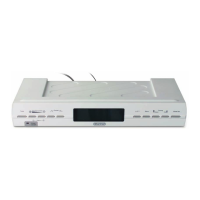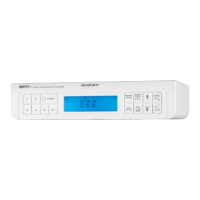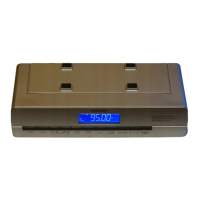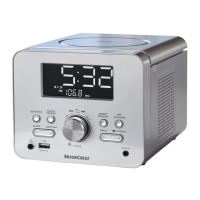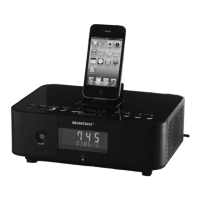- 4 -
Operating Elements
q
Power cable
w
Battery compartment KH 2187: on the underside,
KH 2188: at the rear
e
Wire aerial
r
Speaker
t
Button SNOOZE
y
Button HOUR
u
Button MIN (KH 2188: MINUTE)
i
Button SLEEP
o
Button AL. ON
a
Button AL. OFF
s
Button TIME
d
Frequency scale
f
Display
g
Volume regulator
h
Slide switch MODE AUTO (AL)/OFF/ON
j
Switch for alarm mode ALARM/RADIO
k
Waveband selector
BAND FM/AM
l
TUNING regulator
Commissioning
Setup
• Unpack the radio alarm and all ancillaries.
• Remove all transport restraints and adhesive
tape/films.
Attention!
Do not permit small children to play with the
plastic packaging. There is a risk of suffocation!
• Position the radio alarm on a level and horizontal
surface.
Inserting the batteries
Power-cut protection
Through the insertion of a 9 V block battery (Type
6LR61) you will avoid that, in the event of a power
failure, the functioning of the device is interrupted
and, as a result, saved settings, such as time and alarm
time, are lost. The battery ensures that the radio
alarm continues to function with an emergency
operation, also during a power failure. On restoration
of the power supply, the correct time will appear
automatically on the display
f
.
Note:
The alarm, radio and display do not function
with battery-power.
• Open the battery compartment
w
and insert
a 9 V block battery (Type 6LR61).
Handling batteries
Leaking batteries can cause damage to the
radio alarm.
• If you do not intend to use the device for an
extended period, remove the battery.
• Should the batteries leak, clean the battery
compartment with a dry cloth whilst wearing
protective gloves.
Note:
Rechargable batteries cannot be charged via
the battery connection. In the event of an extended
power cut (several hours), the clock and alarm
times must be checked and possibly re-adjusted.
Assembly
Before operating the device, make sure that it is in
a faultless condition. If it is not, it may not be used.
• Insert the plug into a power socket. Select a power
socket that is at all times easily accessible, so that
the plug can be quickly withdrawn in the event of
a malfunction.

